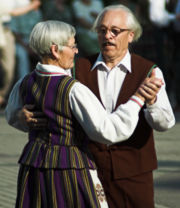
Activity theory (aging)
Encyclopedia

Ageing
Ageing or aging is the accumulation of changes in a person over time. Ageing in humans refers to a multidimensional process of physical, psychological, and social change. Some dimensions of ageing grow and expand over time, while others decline...
occurs when older adults stay active and maintain social interactions.
The activity theory rose in opposing response to the disengagement theory
Disengagement theory
The disengagement theory of aging states that "aging is an inevitable, mutual withdrawal or disengagement, resulting in decreased interaction between the aging person and others in the social system he belongs to". The theory claims that it is natural and acceptable for older adults to withdraw...
. The activity theory and the disengagement theory were the two major theories that outlined successful aging in the early 1960s. The theory was developed by Robert J. Havighurst
Robert J. Havighurst
Robert James Havighurst was a professor, physicist, educator, and aging expert. Both his father, Freeman Alfred Havighurst, and mother, Winifred Weter Havighurst, had been educators at Lawrence University. Havighurst worked and published well into his 80s...
in 1961. In 1964, Bernice Neugarten asserted that satisfaction in old age depended on active maintenance of personal relationships and endeavors.
The theory assumes that a positive relationship between activity and life satisfaction
Life satisfaction
Life Satisfaction is the way a person perceives how his or her life has been and how they feel about where it is going in the future. It is a measure of well being. Life satisfaction has been measured in relation with economic standing, amount of education, experiences, and the location of people...
. One author suggests that activity enables older adults adjust to retirement and is named “the busy ethic”.
The critics of the activity theory state that it overlooks inequalities in health and economics that hinders the ability for older people to engage in such activities. Also, some older adults do not desire to engage in new challenges.
Activity theory reflects the functionalist perspective
Structural functionalism
Structural functionalism is a broad perspective in sociology and anthropology which sets out to interpret society as a structure with interrelated parts. Functionalism addresses society as a whole in terms of the function of its constituent elements; namely norms, customs, traditions and institutions...
that the equilibrium that an individual develops in middle age should be maintained in later years. The theory predicts that older adults that face role loss will substitute former roles with other alternatives.
The activity theory is one of three major psychosocial theories which describe how people develop in old age. The other two psychosocial theories are the disengagement theory, with which the activity comes to odds, and the continuity theory which modifies and elaborates upon the activity theory.
Though in recent years the acceptance activity theory has diminished, it is still used as a standard to compare observed activity and life satisfaction patterns.

